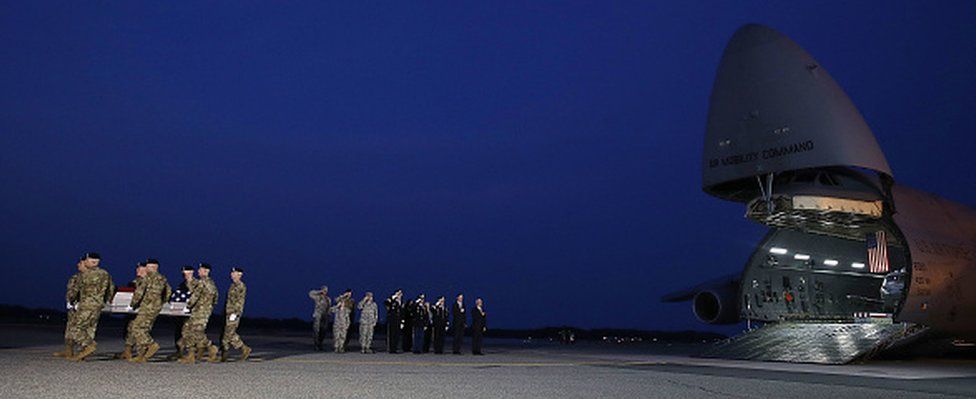How Trump might break Afghan stalemate
- Published

Afghanistan has long been considered the great game, and it turns out all the major participants in the current version of the country's long and violent struggle are all playing for time. They are all playing not to lose.
The Afghan government is unable to establish sovereignty throughout the country. The Taliban keeps attacking but cannot return to power. Pakistan fears a political solution that would increase Indian influence in the region. Al-Qaeda is a shell of its former self but still lurks in the shadows. So does the Islamic State. All kinds of networks and power brokers jockey for their piece of the lucrative opium trade that continues to reach record levels.
The United States and its Nato partners have been looking for an exit strategy for at least a decade. But despite a couple of trillion dollars invested thus far, there is little confidence the Afghan government would survive if all the foreign forces withdrew.
President Trump has given the Pentagon permission to deploy several thousand more troops to Afghanistan in the coming months. Given Trump's hectoring, it's likely Nato will be asked to do more as well.
As the saying goes, the more things change, the more they remain the same.
Even as the Trump administration is prepared to modestly up the ante in Afghanistan, there is little discussion as to the country's continued importance to American and western security.
The Bush administration sent military forces to Afghanistan in 2001 to eliminate the al-Qaeda safe haven in the aftermath of the 11 September hijackings. That objective was achieved within a few months.
But to ensure that Afghanistan would never again become a terrorist safe haven, the US and its Nato partners launched an ambitious nation-building project to create something the country has never really had - a functioning central government - and recreate something it lost - a real economy not reliant on poppy cultivation.
This remains a work in progress.
When the Bush administration shifted its attention to Iraq in 2003, the Taliban made a comeback with significant help from Pakistan, which provided both shelter and support, seeing Afghanistan as part of its broader struggle with India.
After an intensive review in 2009, the Obama administration added tens of thousands of troops for a limited time to recapture lost momentum and create conditions for a negotiated settlement between the Taliban and the Afghan government. It tried and failed to enlist Pakistan as a genuine strategic partner.
Perhaps believing his own talking points about the strategic defeat of al-Qaeda and its allies following the death of Osama bin Laden, President Obama hoped to end America's longest war, but couldn't. There were negotiations about negotiations, but the fighting never stopped.
Today there are some 13,000 US and Nato troops in Afghanistan with a limited mission, to continue to train and support Afghan forces in their struggle against the Taliban, and to conduct counterterrorism operations against extremist groups, some of which identify with the so-called Islamic State.
In that regard, a modest increase in force levels in Afghanistan also makes sense given trend lines in Iraq and Syria. The Islamic State terror group will be in need of new operating locations. They have a small presence already. It's important to Afghanistan's future to keep it small.
The overall strategy is unchanged, adding time to the Afghan clock in the hope that the government can improve its performance, gain greater support from its people, and inflict enough damage on the Taliban to create conditions for a negotiation.
More troops may provide military commanders with more tactical options, but it is unlikely to change the basic dynamic of the conflict. It will remain a military stalemate until there is a political breakthrough.
But to get there, two strategically important things need to happen.
The president, who has chosen to keep Afghanistan at arm's length, needs to make the mission more politically sustainable. Notwithstanding his desire for political wins, the Afghan war is not going to end any time soon, certainly not in his first term. He needs to tell the American people that US and Nato forces will still be in Afghanistan in 2021.
He also needs to be much tougher on Pakistan. Both Mullah Omar, the Taliban's leader at the time of the 11 September 2001 attacks, and Bin Laden died (the al-Qaeda leader killed by the US) on Pakistani soil. That is not a coincidence. There is no prospect of success in Afghanistan without dealing with Pakistan's duplicity.
Trump was right when he said during his recent trip to Saudi Arabia that the Islamic world must drive extremists out of their countries. If this is the first building block of a Trump doctrine, Pakistan should be its first test case.
P.J. Crowley is a former US Assistant Secretary of State and author of Red Line: American Foreign Policy in a Time of Fractured Politics and Failing States.
- Published20 June 2017
- Published6 June 2017
- Published12 January 2017